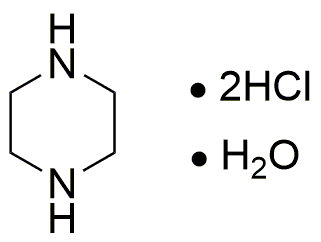Piperazine dihydrochloride monohydrate is widely utilized in research focused on:
- Pharmaceutical Development: This compound serves as an important intermediate in the synthesis of various pharmaceuticals, particularly in the production of anti-anxiety and anti-depressant medications.
- Veterinary Medicine: It is commonly used in veterinary formulations to treat parasitic infections in animals, providing a safe and effective solution for pet health.
- Analytical Chemistry: Researchers employ it as a reagent in analytical methods, including chromatography, to help identify and quantify other chemical substances.
- Polymer Chemistry: Piperazine dihydrochloride monohydrate is utilized in the synthesis of polymeric materials, enhancing properties like flexibility and durability in various applications.
- Biochemical Research: It acts as a buffer component in biological assays, helping to maintain pH levels and improve the reliability of experimental results.
General Information
Properties
Safety and Regulations
Applications
Piperazine dihydrochloride monohydrate is widely utilized in research focused on:
- Pharmaceutical Development: This compound serves as an important intermediate in the synthesis of various pharmaceuticals, particularly in the production of anti-anxiety and anti-depressant medications.
- Veterinary Medicine: It is commonly used in veterinary formulations to treat parasitic infections in animals, providing a safe and effective solution for pet health.
- Analytical Chemistry: Researchers employ it as a reagent in analytical methods, including chromatography, to help identify and quantify other chemical substances.
- Polymer Chemistry: Piperazine dihydrochloride monohydrate is utilized in the synthesis of polymeric materials, enhancing properties like flexibility and durability in various applications.
- Biochemical Research: It acts as a buffer component in biological assays, helping to maintain pH levels and improve the reliability of experimental results.
Documents
Safety Data Sheets (SDS)
The SDS provides comprehensive safety information on handling, storage, and disposal of the product.
Product Specification (PS)
The PS provides a comprehensive breakdown of the product’s properties, including chemical composition, physical state, purity, and storage requirements. It also details acceptable quality ranges and the product's intended applications.
Certificates of Analysis (COA)
Search for Certificates of Analysis (COA) by entering the products Lot Number. Lot and Batch Numbers can be found on a product’s label following the words ‘Lot’ or ‘Batch’.
*Catalog Number
*Lot Number
Certificates Of Origin (COO)
This COO confirms the country where the product was manufactured, and also details the materials and components used in it and whether it is derived from natural, synthetic, or other specific sources. This certificate may be required for customs, trade, and regulatory compliance.
*Catalog Number
*Lot Number
Safety Data Sheets (SDS)
The SDS provides comprehensive safety information on handling, storage, and disposal of the product.
DownloadProduct Specification (PS)
The PS provides a comprehensive breakdown of the product’s properties, including chemical composition, physical state, purity, and storage requirements. It also details acceptable quality ranges and the product's intended applications.
DownloadCertificates of Analysis (COA)
Search for Certificates of Analysis (COA) by entering the products Lot Number. Lot and Batch Numbers can be found on a product’s label following the words ‘Lot’ or ‘Batch’.
*Catalog Number
*Lot Number
Certificates Of Origin (COO)
This COO confirms the country where the product was manufactured, and also details the materials and components used in it and whether it is derived from natural, synthetic, or other specific sources. This certificate may be required for customs, trade, and regulatory compliance.


